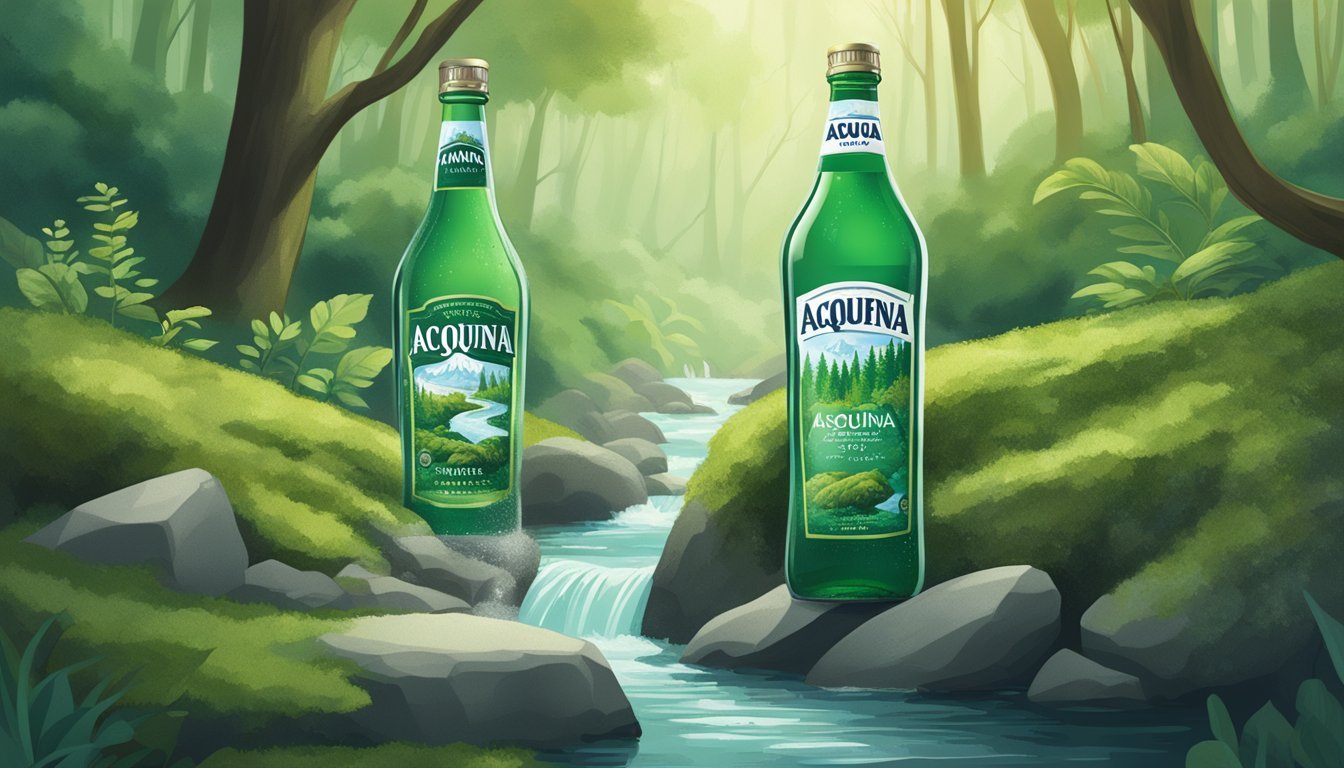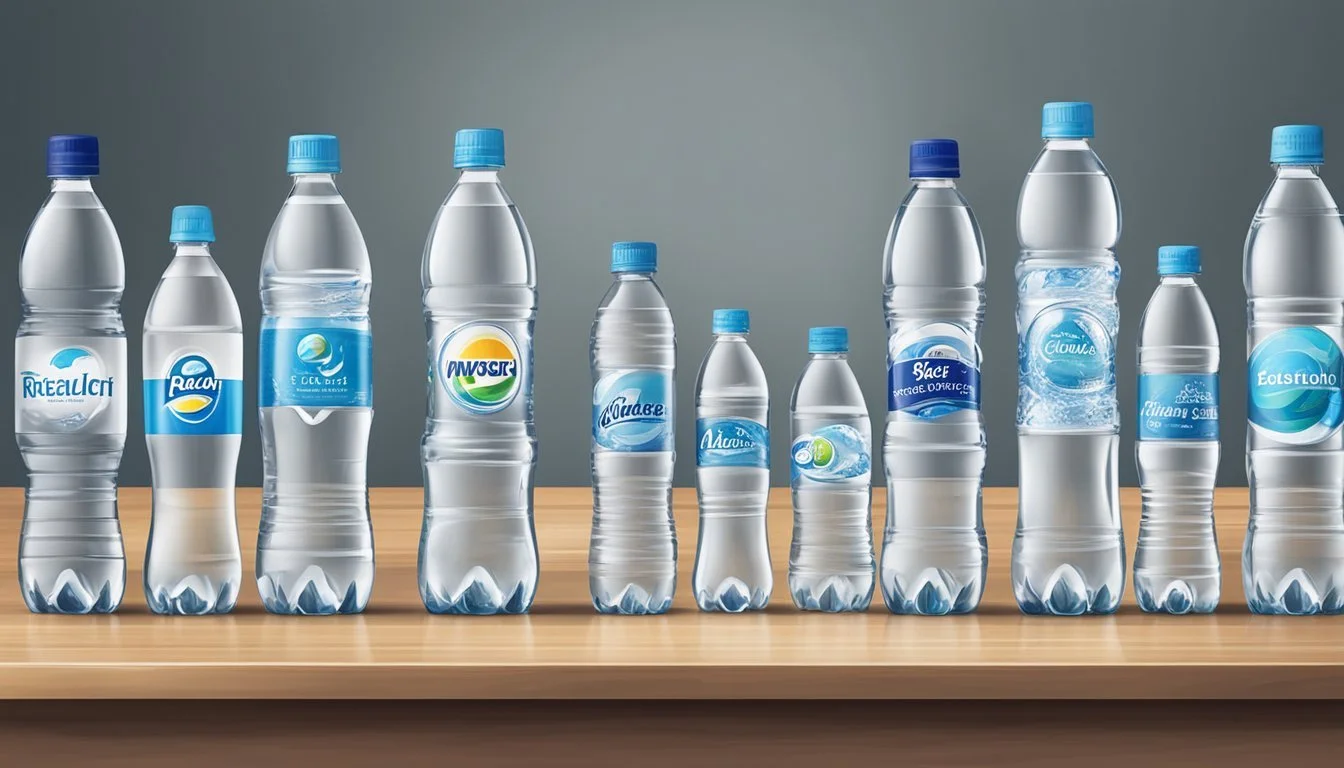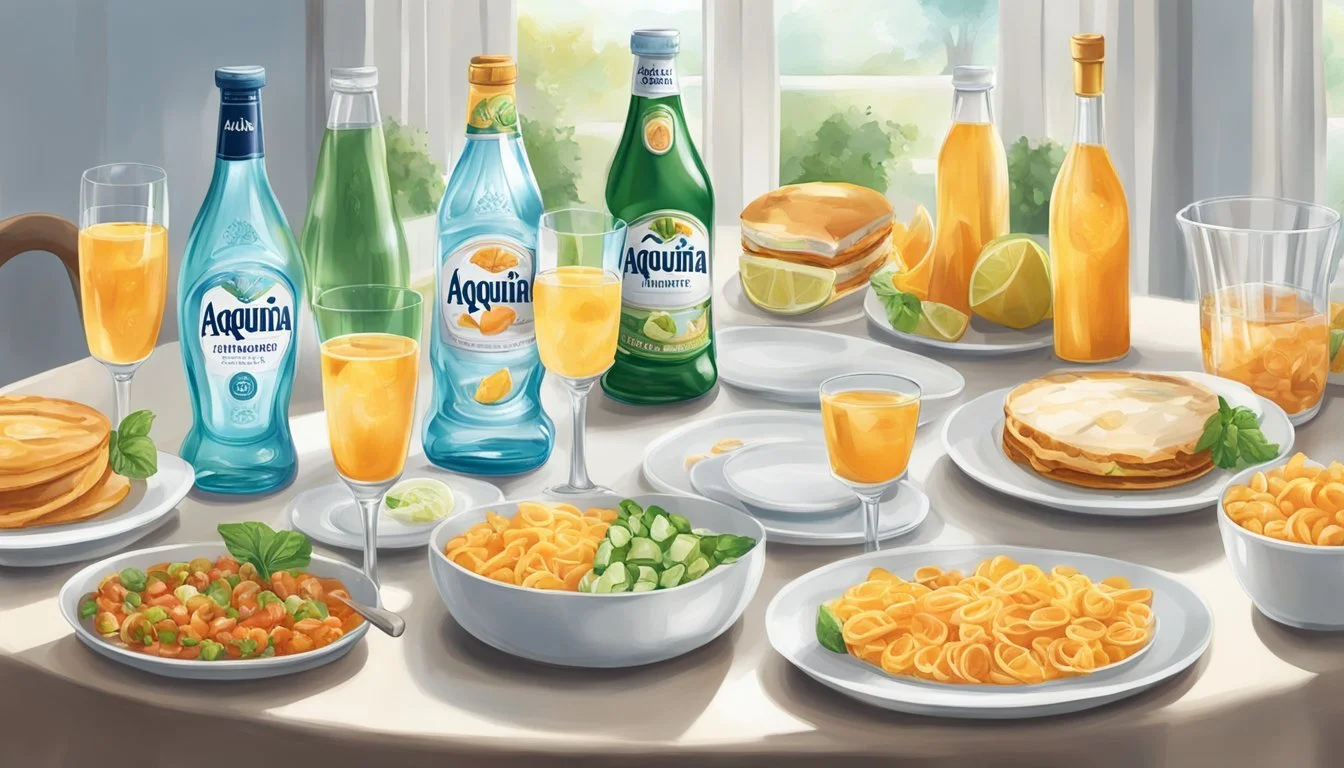Acqua Panna vs. Aquafina
Comparing Quality and Taste of Bottled Waters
When deciding between bottled water brands, consumers are often faced with a plethora of options each touting purity, taste, and quality. Acqua Panna and Aquafina represent two distinct choices within the bottled water market. Acqua Panna, sourced from Tuscany, Italy, positions itself as a premium natural spring water known for its smooth taste and terroir, often associated with fine dining experiences. On the other hand, Aquafina, a purified drinking water produced by PepsiCo, prides itself on a rigorous purification process, which includes reverse osmosis.
The distinction between these brands not only lies in their origin but also in their processing techniques and target market segments. While Acqua Panna is bottled at the source and naturally filtered through Tuscan hills, Aquafina is collected from municipal sources and then subjected to a seven-step purification system designed to ensure consistent taste and purity. The branding strategies of these companies reflect their unique selling propositions—Acqua Panna emphasizes heritage and naturalness, whereas Aquafina focuses on purity and science.
The choice between Acqua Panna and Aquafina may ultimately come down to personal preference regarding taste and the importance of the water's source and treatment process. Some consumers might prefer the taste profile of a natural spring water, while others may prioritize the assurance of purity offered by heavily filtered waters. The debate on which bottled water is better continues as individual tastes and values differ.
The Basics of Bottled Water
Bottled water offers consumers a portable and convenient way to stay hydrated. This section covers the fundamental aspects, from different types of bottled water to the varying sources and their health implications.
Types of Bottled Water
Bottled water can be broadly categorized based on its treatment process and content:
Spring Water: This type originates from natural springs and contains various minerals.
Mineral Water: Similar to spring water but with a higher mineral content that must remain consistent at the source and after bottling.
Alkaline Water: Water with a pH higher than 7, often achieved through a process called electrolysis.
Purified Water: Water that has been treated to remove chemicals and contaminants, often using reverse osmosis or distillation.
Understanding Water Sources
The source of bottled water is pivotal in determining its quality and taste:
Natural Springs: Water sourced from an underground formation that naturally flows to the earth's surface.
Municipal Supplies: A common source for many brands, including Aquafina, where water undergoes purification processes.
Treatment Processes:
Reverse Osmosis: A purification method that removes contaminants by forcing water through a semipermeable membrane.
Electrolysis: The process of splitting water into oxygen and hydrogen to create alkaline and acidic waters.
Health and Hydration Fundamentals
When discussing bottled water, health and hydration are at the core of the conversation:
Minerals and Electrolytes: Essential for proper body function, many bottled waters are enriched with minerals such as calcium and magnesium.
Hydration: Adequate hydration is crucial for maintaining health; bottled water provides a sterile and convenient option for on-the-go individuals.
Bottled water standards are regulated to ensure safety for consumption, and brands can differentiate themselves based on their mineral content and pH levels.
Brand Overview: Acqua Panna and Aquafina
When comparing bottled water brands, Acqua Panna and Aquafina each bring distinctive qualities to the table, from Acqua Panna's historical source to Aquafina's advanced purification technique. This section will examine their origins, sources, and methods that define their place in the bottled water industry.
Acqua Panna's Origins and Source
Acqua Panna takes its name from the Panna estate located in Tuscany, Italy, where its journey begins. Sourced from a spring in the serene hills of Tuscany, this natural mineral water traverses through limestone formations, naturally filtering and absorbing minerals before being bottled. Acqua Panna boasts a historical reputation, being recognized by Florentine nobility since the Renaissance for its purity and taste. The water from this region is cherished for its softness and balanced mineral composition, which are characteristics derived from the unique geography of the mountain valley aquifer from which it emerges.
Aquafina's Purification Process
In contrast, Aquafina is a brand of purified water that originates from public water sources. It undergoes a rigorous filtration process utilizing a high-tech treatment system. This process includes reverse osmosis, ultraviolet light, and ozone sterilization, ensuring the water achieves Aquafina's standard of purity and crisp taste. While not sourced from natural springs, Aquafina's state-of-the-art purification technology illustrates the brand's commitment to delivering a clean, pure product by systematically removing substances more aggressively than typical filtration methods.
Through these distinct approaches, both Acqua Panna and Aquafina have carved niches for themselves as leading brands within the bottled water industry—whether it's Acqua Panna with its storied Tuscan heritage or Aquafina with its technologically advanced purification.
Taste and Composition Comparison
This section explores how Acqua Panna and Aquafina differentiate in their mineral content and flavor profiles, as well as their respective pH levels and potential health impacts.
Mineral Content and Flavor
Acqua Panna touts a smooth taste that is often attributed to its balanced mineral content, sourced from Tuscany, Italy. It contains minerals like calcium, magnesium, and silica, which contribute to its noted silky texture and subtle taste. In contrast, Aquafina is well-known for its purity and crisp taste, achieved through a rigorous purification process, including reverse osmosis. Aquafina's mineral content is minimal, as the purification removes most naturally-occurring minerals.
Mineral Comparison:
Acqua Panna: Calcium, Magnesium, Silica.
Aquafina: Traces of minerals (removed during purification).
The taste enthusiasts generally recognize Acqua Panna for its natural sweetness and mild flavor, due to its unique blend of minerals. Aquafina is characterized by its clean, refreshing water taste, which results from low mineral content.
PH Levels and Health Impacts
The pH level of bottled water can influence both its taste and health effects. Acqua Panna has a neutral to slightly alkaline pH, which is believed by some to be beneficial for neutralizing the body's acidity, though evidence supporting this is limited. On the other hand, Aquafina typically presents a neutral pH due to its purification process, aligning with the pH levels of pure water.
PH Levels:
Acqua Panna: 7.0 – 8.0 (Neutral to slightly alkaline).
Aquafina: Neutral (Approximately 7.0).
The health implications of drinking water with different pH levels are the subject of much debate. Some believe that alkaline water can help in reducing acid reflux. However, it is important to note that no strong evidence conclusively links the pH of water to significant health benefits. Both Acqua Panna and Aquafina are safe to drink and meet the regulatory standards for bottled water.
Environmental and Ethical Considerations
Bottled water brands Acqua Panna and Aquafina face scrutiny over their environmental impact and the ethical implications of their production and distribution practices. This section will address their approaches to sustainability and recycling.
Bottled Water and Sustainability
The sustainability of bottled water is a pressing environmental concern. For both Acqua Panna and Aquafina, the production process—from extracting water to packaging—involves significant resource consumption. Acqua Panna, sourced from Tuscany, Italy, prides itself on natural spring water which can raise questions regarding the depletion of natural water reserves and the impact on local ecosystems. Aquafina, a purified water product by PepsiCo, originates from municipal sources and its processing entails substantial energy use for purification.
Environmental footprint: The extraction and bottling processes account for energy consumption and CO2 emissions, potentially affecting climate change.
Water source management: Assessments of the sustainability of the water sources help to ensure that production is not detrimental to local water tables.
Production and Recycling Practices
The ethics of bottled water also involve production and recycling practices. Aquafina employs a process known as reverse osmosis and has initiatives aimed at reducing its packaging's environmental toll. Conversely, Acqua Panna focuses on preserving the quality and heritage of its natural spring, which may conflict with large-scale commercial exploitation.
Packaging materials:
Acqua Panna: Emphasizes the use of glass bottles, which are widely recyclable and may appeal to environmentally conscious consumers.
Aquafina: Uses lightweight and recyclable plastic bottles to minimize waste.
Recycling initiatives: Both brands are expected to advocate for and facilitate effective recycling to mitigate the environmental impact of their products.
The ethical dimension extends beyond environmental considerations to include the social impact of corporate practices, the right to water, and the responsibility towards communities affected by bottling operations. Consumers increasingly weigh these factors alongside convenience when choosing their bottled water.
Consumer Choices and Preferences
When choosing bottled water, consumers weigh factors such as packaging convenience and brand reputation. These elements significantly influence purchase decisions, reflecting individual needs and brand affinities.
Packaging and Convenience
Acqua Panna and Aquafina present different packaging options catering to varying consumer preferences. Acqua Panna is often recognized for its glass bottles, which are preferred by consumers looking for a more premium experience and possibly better taste preservation. On the other hand, Aquafina is commonly available in plastic bottles, which might be chosen for their lightweight and easy disposal features.
Convenience also comes into play with bottle size and the ease of acquiring the product. Aquafina, widely distributed by PepsiCo, is readily available in many retail outlets, providing consumers with accessible hydration options. In contrast, Acqua Panna's Italian spring water might present some degree of scarcity in certain markets, influencing consumer choices based on availability.
Brand Perception and Loyalty
The perception of Acqua Panna as a gourmet and luxury brand can influence consumers' loyalty and repeat purchases, especially among those who prioritize the quality and source of their bottled water. Its Tuscany-sourced water, bottled without additional treatment, might attract consumers seeking a natural and pure option.
Aquafina, positioned as a purified drinking water, may appeal to consumers looking for reliable and consistent quality, being a product of the Coca-Cola Company. Its wide presence in the market may also instill a strong brand recognition, fostering consumer loyalty. However, its taste and composition, which includes added minerals, can also play a significant role in how consumers perceive the brand and make their choices.
Regulations and Safety Standards
When considering bottled water choices such as Acqua Panna and Aquafina, it is essential to understand the regulations and safety standards that govern their quality. This ensures that the consumer is drinking water that is both safe and meets strict purity criteria.
Quality Control
Both Acqua Panna and Aquafina are subject to rigorous quality control procedures. Acqua Panna touts its mineral composition and flavor that results from a 14-year filtration process through the aquifer beneath Tuscany. This natural process contributes to its distinct smooth taste. The brand asserts a high standard of smoothness and taste for its water. On the other hand, Aquafina emphasizes its purity, achieved through a meticulous process including reverse osmosis. Aquafina meets the FDA's highest standards for bottled water, indicating that it has been rigorously tested to ensure it is free from harmful contaminants.
Government and Industry Regulations
The bottled water industry is regulated by various government and industry bodies to ensure consumer safety. In the case of Aquafina, the United States Food and Drug Administration (FDA) is the primary regulatory body, setting standards based on EPA public drinking water guidelines. The FDA's regulation ensures that bottled water, like Aquafina, meets strict safety benchmarks. The Maximum Contaminant Level (MCL) is a critical measure set by the FDA, representing the maximum concentration of a substance that is allowed in public drinking water.
Acqua Panna, while subject to rigorous testing, must adhere to both local Italian regulations as well as international standards if it is exported. This is in line with industry standards for water quality, which include various processes and controls to maintain the safety and quality of the water before it reaches the consumer.
Pairing Water with Food and Beverages
High-quality bottled waters like Acqua Panna and Aquafina can enhance the dining experience, whether paired with a meal at a renowned restaurant or while enjoying a cup of coffee or tea.
Restaurants and Culinary Experiences
Acqua Panna is often chosen by upscale restaurants for its natural purity and ability to complement fine dining. Originating from Tuscany, Italy, a region known for its rich culinary heritage, this water is a favorite for food pairings due to its balanced mineral content and smooth taste. Restaurants favor Acqua Panna for its potential to enhance the flavors of sophisticated dishes without overpowering them.
Ideal Food Pairings with Acqua Panna:
Italian Cuisine: Enhances the subtleties of pasta and risotto.
Seafood: Complements delicate flavors of fish and shellfish.
Wine: Pairs seamlessly with both red and white wines, cleansing the palate.
Water as a Complement to Coffee and Tea
Water quality can greatly influence the taste of coffee and tea. Aquafina, known for its purification process, provides a neutral base that allows the natural flavors of coffee and tea to shine. With its consistent taste profile, Aquafina is a suitable choice for brewing as it ensures the water does not introduce any additional flavors to the beverages.
Enhancing Coffee and Tea with Water:
Coffee Brewing: Use purified water like Aquafina to maintain the integrity of the coffee's flavor profile.
Tea Pairings: A neutral-tasting water ensures the tea's aroma and taste remain unaltered.
Innovations in Bottled Water
The bottled water industry is continually evolving, introducing innovative flavors and functional ingredients alongside sustainable packaging solutions to meet consumer demands and environmental considerations.
Flavored and Functional Waters
Companies have expanded beyond traditional bottled water to include a variety of flavored and functional waters. Consumers are now able to choose from a selection of waters enhanced with vitamins, minerals, and natural flavors without added sugars or artificial ingredients. For instance, Acqua Panna has maintained its position by focusing on the natural purity of their product, whereas Aquafina offers a range of flavored options under its Aquafina FlavorSplash line.
Functional water has seen substantial growth, with brands infusing waters with everything from antioxidants to caffeine. These waters provide consumers with health benefits such as improved hydration, energy, and wellness boosters.
Emerging Trends in Packaging
The bottled water industry is witnessing significant shifts in packaging trends. In response to growing environmental awareness, brands are adopting more eco-friendly packaging solutions. For example:
Boxed Water Is Better has pioneered the use of cartons made from paper, a renewable resource, challenging traditional plastic bottles.
Companies are increasingly using recycled plastic (rPET) for their bottles, and some are committing to fully recyclable materials in the near future.
Compact and biodegradable bottles: There's a focus on reducing packaging size and introducing biodegradable materials to reduce the environmental footprint.
Innovative packaging is not only about reducing environmental impact but also about providing convenience, such as collapsible bottles for ease of transport when empty. With consumers valuing sustainability, these packaging trends are becoming as significant as the product itself.
Comparative Analysis of Other Brands
In assessing the overall landscape of bottled water, Acqua Panna and Aquafina represent different market segments. It is essential to gauge how they stand compared to both luxury and standard water brands in the industry to gain a clearer understanding of their positioning.
Comparisons With Other Premium Brands
Acqua Panna positions itself among premium brands such as Evian, Fiji, VOSS, and Perrier. Unlike the neutral pH level of Aquafina, Acqua Panna boasts of a naturally alkaline composition with a pH that typically hovers around 8. The source of Acqua Panna water, from the Apennine Mountains, lends a unique mineral composition to the water, making it distinct from Evian, which originates from the French Alps. Fiji water is known for its high silica content and smooth taste, originating from an artesian aquifer in Fiji.
VOSS water, sourced from Norway, also competes in the high-end market with its minimalist glass bottle and artesian water. Meanwhile, Perrier is distinct for its carbonation, offering a sparkling alternative with a variety of natural flavors. Acqua Panna's non-carbonated quality aligns more closely with VOSS and Fiji than with Perrier.
Value Offerings in the Market
Turning to value offerings, Aquafina, a purified water product by PepsiCo, is often compared with Dasani, Coca-Cola's version of purified water. Both are widely available and provide cost-effective hydration solutions.
In terms of smart and enhanced waters, Smartwater, by Coca-Cola, infuses electrolytes for a crisp taste, aiming at consumers looking for added benefits in their water. LIFEWTR further diversifies the market by including pH balance and electrolytes in its purified water, along with artist-designed labels to appeal to an audience valuing both hydration and design.
CORE Hydration is another notable contender which markets itself as a competitor in the enhanced water category, with a pH that matches the human body's natural pH level. For those favoring natural sources, spring waters consist of numerous brands that utilize spring sources across continents, emphasizing the mineral content and purity of their offerings. The breadth of water bottle brands in the market ensures a variety of choices in terms of taste preference, mineral content, source, and price.





